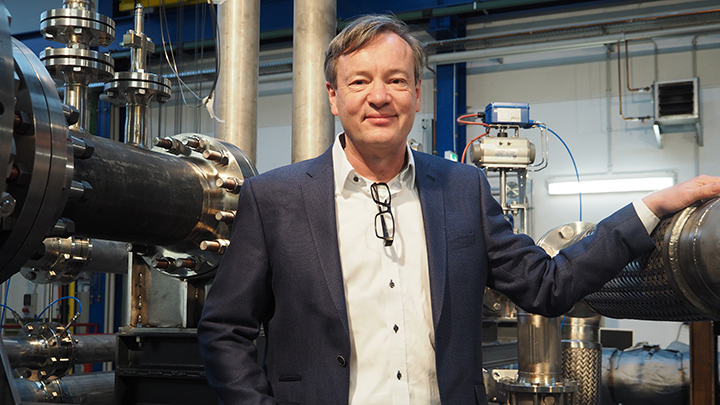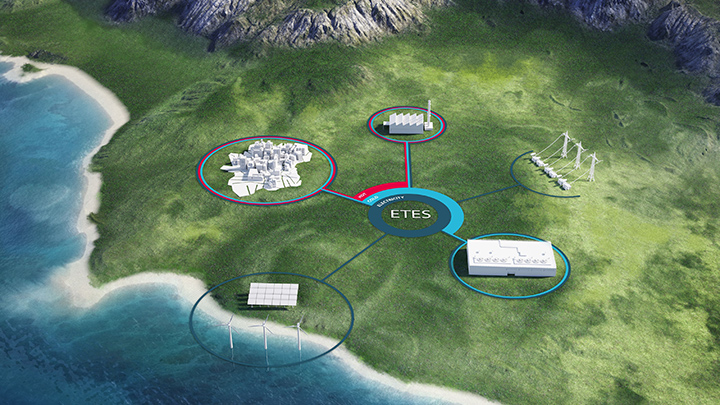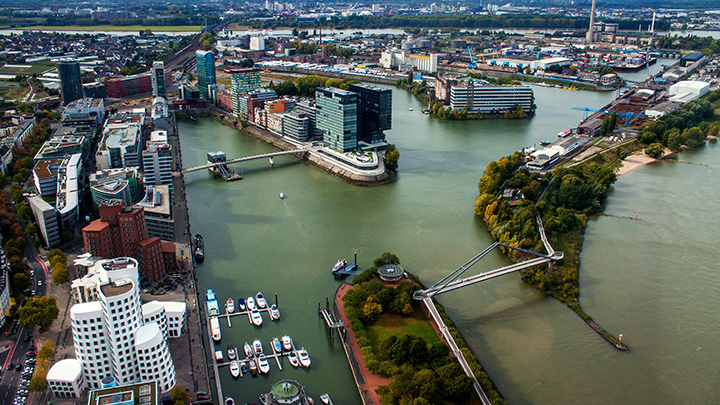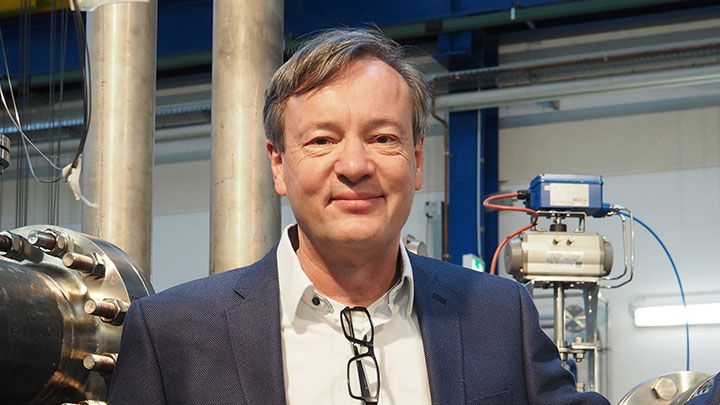Professor Manfred Wirsum on the energy storage tech that will help decarbonize how we heat and cool the places where we live and work
Renewable energies are transforming electricity generation, but what about other sectors? Heating and cooling alone account for 48 percent of the world’s final-energy consumption and 39 percent of its carbon (CO2) emissions. That’s where sector coupling comes in: an old idea with new applications. Discover speaks with Manfred Wirsum, Head of the Institute for Power Plant Technology, Steam and Gas Turbines at RWTH Aachen University in North Rhine-Westphalia, Germany, where he’s been studying the coupling of electricity, heating and cooling with a new electro-thermal energy storage (ETES) system by MAN Energy Solutions.
By Oliver Sachgau
Professor Wirsum, what is sector coupling and why do we need it?
Dr. Prof. Manfred Wirsum: Sector coupling integrates energy consuming sectors into the electricity supply sector, where we have the majority of fluctuating renewables (solar, wind and hydropower). And doing so lets us use these near carbon-free forms of energy in areas that have been otherwise hard to decarbonize. Just take heating as an example. Most heat supply systems continue to run on fossil fuels, and more often than not district heating networks are fed by fossil fuels from power plants. Decarbonization of the global heating market is far below 10 percent – and bringing renewable energy into this market is an economical way to lower emissions.

RWTH Aachen University professor Manfred Wirsum is coordinating a project to investigate MAN ETES energy-storage technology potential in North Rhine-Westphalia.
What hurdles stand in the way of making sector coupling a reality?
The hurdles are mainly economic, not technical. In the past, for example, we had solutions like night storage heaters that could easily and inexpensively produce heat from electrical energy. A kilowatt-hour of electricity already costs so much, much more than firing gas or utilizing waste heat from a conventional plant.
Sector coupling is often tied to the problem of finding a way to store electricity generated out of renewable sources. What exactly is the problem there?
Well, for more than 100 years the energy industry has been producing electricity and heat based on demand. But what happens when you use a variable source of energy, such as sun or wind? It’s an ancient problem – the German humorist and poet Wilhelm Busch described it in a poem about a miller and his windmill. The miller complains: When there’s grain, there’s no wind, and when there’s wind, there’s no grain. Of course, back then no one thought about storing wind power, but they recognized products could inherently store energy. For the miller, that was grain and flour, but there are modern-day equivalents.

MAN ETES is a highly efficient trigeneration energy system, providing heating, cooling and electricity on demand.
It’s a question of flexibility. If a municipal utility has a system like ETES in its portfolio, it can be used to better balance the supply and demand of electricity and heat.
How can an electro-thermal energy storage (ETES) system solve this problem?
ETES systems increase the amount of renewable energy in the heating, cooling and power sectors in a way that’s just not possible when the energy system is considered as individual silos. And with hot side temperatures ranging from 70°C to 150°C
and cold down to zero, they allow for a wide range of applications, from sterilization and comfort heating of large buildings to cooling data centers.
Is ETES technology economically viable?
Absolutely, but for simplicity’s sake let’s just look at it from one aspect of the system: heating. Heat pumps are always attractive when we can multiply the electrical energy we’re paying for. We do this by tapping waste heat, environmental heat and otherwise unusable heat reservoirs. And this multiplication factor, between 1.5 and four, five or six depending on the application, determines the profitability: the lower the temperature of the application, like for household heating, the higher the economic feasibility. Now, ETES is a heat pump system that can be used on an industrial scale, making it far more efficient and cheaper per kilowatt of installed capacity. And the system escalates exponentially. Double the dimensions and these machines get roughly four times more power at less cost.
You’ve been conducting a feasibility study on using the MAN Energy Solutions’ ETES system (MAN ETES) in Aachen, in North Rhine-Westphalia. What do you find unique about their solution?
Remember, it’s all about transporting energy from a cold side to a hot side. So, with MAN ETES the essential difference is the gas being used in the process – CO2 as refrigerant –, which allows for temperatures that can meet both the typical cooling requirements for air conditioning, data center cooling or cold storage cooling, just to name a few examples, and the typical heating requirements for, say, district heating. The MAN ETES system is excellent at meeting these requirements.

Energy storage technologies are highly relevant for urban regions, such as North Rhine-Westphalia, where industry is strong and energy requirements are high.
In Denmark, the port city of Esbjerg will use two of MAN Energy Solutions’ ETES systems to decarbonize their heat supply. Why is that location specifically so suitable?
Basically, for sector coupling via heat pumps you need a reservoir where you can absorb heat at low temperatures. Water is ideal for this, i.e., a coastal city with access to the sea at temperatures of maybe 10-15°C in summertime and 5°C in wintertime. This is a nearly inexhaustible reservoir of energy for such applications, even if the seawater temperature seems low. The system can be operated with relatively constant conditions, in both summer and winter. That’s why a port city like Esbjerg is suitable. We could do it just as well on the Rhine.
Moreover, a municipal utility like DIN Forsyning in Esbjerg also has the requirement to compensate for fluctuations in supply and demand, and a large heat pump operating the district heating network has the potential to compensate for discrepancies. So, it’s a question of flexibility. If a municipal utility has a system like ETES in its portfolio, it can be used to better balance the supply and demand of electricity and heat.
Are there any preliminary insights you can share about the feasibility study in Aachen? What was the original idea for the project?
The original idea among the engineers was that we would like to build an ETES demonstration platform, full ETES, i.e., electricity for cooling and heating as well as reconversion of the energy stored into electricity again, and then research and further develop the system. We’re nearly halfway done with the project and already have some interim results about the potential of ETES. In North Rhine-Westphalia, to phase out coal we’re going to have to replace remote heating capacities. In Aachen, for example, there’s a district heating network served by a lignite power station, which provides very high heat output for the city. In the project, we said we’d split the ETES concept into a heat pump, coupling heat and electricity, and a potential reconversion. We’ve started working with the heat pump option, specifically looking if it’s feasible to provide district heating as a partial replacement for the heat output from the lignite power plant.
You’d need support from various levels there, right?
Well, the problem is that the electricity for this ETES system is subject to the Renewable Energy Sources Act (EEG, Erneubare-Energien-Gesetz) and other taxes. We can’t say we have electricity from wind power. At the moment, when this electrical energy has to be routed via the grid, even if ETES isn’t the end user, the distributor has to pay the surcharges. Then the project immediately jumps from being potentially economically viable to non-viable. You have to look at each use case specifically because there are possible solutions. For example, for a windfarm no longer being subsidized, you could send the energy to an ETES system without going through the public power grid and avoiding levies. So, there are definitely opportunities for standalone solutions in the future, and there are technologically and thermodynamically feasible approaches to using an ETES system. You could save a lot of carbon emissions.
Electro-thermal energy storage (ETES)
AN ETES is an effective, flexible solution that addresses many of the challenges involved in reducing CO2 emissions and increasing renewable energy production – by coupling the electricity, heating and cooling sectors.
About the author
Oliver Sachgau is a Berlin-based German-Canadian writer and journalist, focused on financial topics. His work has appeared in Bloomberg, the Washington Post, Fortune and The Independent.

About Manfred Wirsum
Manfred Wirsum is a professor at RWTH Aachen University. He has a diploma in engineering from the University of Stuttgart, a Master of Science from the University of Wisconsin/Madison, and a Ph.D. and Habilitation from the University of Siegen. He worked for Alstom Power Switzerland for nearly ten years. Since 2010, he has been with RTWH Aachen University, where he is Head of the Institute for Power Plant Technology, Steam and Gas Turbines. The work at the institute specializes in research centered on turbomachines, hydrogen and emission-reduced energy conversion systems. Prof. Wirsum is also an honorary professor at Tsinghua University Beijing and at Shenyang Institute of Engineering.
Explore more topics
MAN Energy Solutions is now Everllence.
We have adopted a new brand name and moved to a new domain: www.everllence.com. This page will also be relocated there shortly. We are working on shifting all pages to www.everllence.com.
